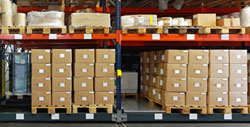Articles
Sustainability: More Than Just Products
Categories: Distribution & Supply Chain, Innovations, Trends & Technology, Sustainability & ESG
By Michael Wilson | May 14, 2018 << Back to Articles
Based on trends witnessed in the past decade or so, jansan distributors can certainly count on at least one thing to continue into 2015: the emphasis on operating in a green and sustainable manner, which inherently involves packaging.
Distributors are increasingly moving away from conventional packaging programs and materials in favor of what we call eco-packaging. This involves using fewer materials along with inputs that are recycled, made from renewable resources, decomposed with less impact on landfills, or are quite simply reused. In addition to helping reduce their environmental footprint and that of their customers, eco-packaging can pay off for distributors in a number of ways, including:
- Cost savings. Reducing excess packaging can result in lighter packaging, which helps to lower shipping costs. For businesses that have a large-scale supply chain, even a small amount of savings per shipment can add up to substantial cost savings. Additionally, reusing materials directly helps to reduce the amount spent on packaging materials.
- Meeting customer requirements. Some customers now insist that their vendors, including distributors, meet specific green and sustainable guidelines. Distributors taking steps toward eco-packaging now are better prepared to serve these customers in the future.
- Attracting new customers. Clients often will select a vendor based on how environmentally responsible it is. Recent research by Nielsen found that two-thirds of all global consumers would prefer to buy products from a company that has implemented socially responsible policies, such as environmentally friendly packaging or other forms of corporate responsibility.
- Optimizing shipments. By using packaging materials and specific eco-packaging designs to minimize waste and increase efficiency, distributors can reduce their transportation and energy costs.
It Starts With an Audit
One of the first ways distributors can start the process of developing an eco-packaging strategy is to conduct a waste audit. This helps establish a baseline that is used to measure progress and quantify the types and amount of waste generated in a distributorship, how much can be or is recycled or reused, and how much is simply discarded. Most of this waste involves materials such as cardboard, paper, metal, and plastics.
According to a study released in November 2013 by nationwide waste collection and disposal company Waste Management, nearly half of the large corporations and manufacturers surveyed had conducted a waste audit in the past five years and another 24 percent had done so in the past year. Interestingly, the percentages were even higher for small to mid-sized companies—63 percent had conducted a waste audit in the past year.
A side benefit of conducting a waste audit, according to the report, is that it gets employees much more engaged in waste reduction overall, which is a subject that historically was given little thought. This awareness alone often helps companies develop an eco-packaging strategy. However, distributors should know that conducting a waste audit provides just a snapshot of current conditions. In order to develop an effective baseline, two or more audits should be conducted at different times of the year to generate a more complete picture.
What It Looks Like
According to the Waste Management report, the most common and popular eco-packaging program is simply using shredded paper as packaging materials. The report found that 75 percent of large corporations use shredded paper as part of their eco-packaging strategy, which was closely followed (71 percent) by reusing cardboard.
One company that has received accolades in reducing waste and becoming much greener and more sustainable when it comes to packaging is consumer-products company Unilever. According to Humberto Garcia, Unilever packaging manager for environmental sustainability for North America, the company looks at packaging in the context of a product’s total lifecycle. “We want to reduce packaging and make it more sustainable, [as well as] consider the [environmental] impact of the product,” Garcia says.
Because Unilever sells and distributes products to more than 150 countries, the company decided to establish a coherent strategy that can be adopted worldwide. This eco-packaging strategy includes:
- Removing: Wherever possible, removing excess packaging materials such as outer cartons and shrink-wrap film
- Reducing: Shrinking packaging materials to the optimal size reduces waste and weight
- Reusing: Reusing packaging materials from the company’s suppliers
- Renewing: Maximizing the use of packaging materials from renewable sources
- Recycling: Increasing the use of recycled and recyclable packaging materials.
All of these steps, Unilever reports, have helped the company reduce costs and its environmental footprint. Other large companies around the world have developed similar programs as part of an eco-packaging strategy.
While these large companies have ample resources to develop eco-packaging programs, as you can see, it is not necessarily a complicated or involved process. Distributors can adopt such programs for their own operations to do their part to protect the environment and enjoy the financial rewards of eco-packaging.
About the Author.
Michael Wilson is vice president of marketing for AFFLINK™, developers of Rest Assured, a bundle of products designed to protect human health at home, in school, and at work. He may be reached through his company website, www.afflink.com.





